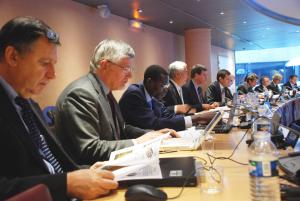Early February, the Fusion Power Coordinating Committee (FPCC) convened in the Headquarters of the International Energy Agency (IEA) in Paris, located at the footsteps of the Eiffel Tower, to report on the state of the fusion art and to coordinate the Committee's future work.
The FPCC was established in 1975 by the IEA Governing Board. Today nineteen IEA Countries, the European Commission, the Russian Federation, the Nuclear Energy Agency (NEA) and International Atomic Energy Agency (IAEA) are members of the FPCC. The FPCC coordinates the IEA activities on fusion and advises the IEA Committee on Energy Research and Technologies (
CERT) and other IEA bodies on fusion policy and technology issues. The current Chairman of the FPCC is Francesco Gnesotto from Italy.
The overall objective of the FPCC is to enhance fusion research, development and deployment activities with a strategic approach to realizing fusion energy in both IEA member countries and in non-member countries. The FPCC accomplishes this objective by promoting, initiating and coordinating international cooperation on fusion under the auspices of the IEA and within the IEA Framework for International Energy Technology Collaboration.



